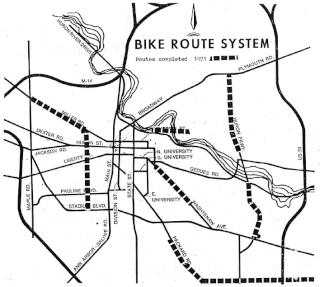
The Ann Arbor Bicycle League (AABL) was a bicycling advocacy organization, active in the 1970s and 1980s, that convinced the city to install its first system of bike paths.
An article in the January 1984 issue of the AABL newsletter summed up some of the group's accomplishments.
AABL At ThirteenWhat should we do next? is a question that the Ann Arbor Bicycle League has pondered many times during its quixotic thirteen year life span. Originally inspired by a small group of Ann Arbor citizens who "sort of came together" to promote the welfare of commuter bicycling in Ann Arbor, AABL has gone through periods of dormancy and has seriously thought of disbanding several times, but goes on in spite of itself.
The original AABL issue was concern over the type of bicycle racks which City Council was considering. It was then that AABL established its reputation for sound factual information and a well developed, rational argument for its positions. A receptive City Council listened and responded. This led to the next issue: persuade City Council to establish "demonstration bike routes" along Seventh, Miller and Huron Parkway. The success of this demonstration and the growing citizen interest in bicycling (and support of AABL) led to the resolution in Council to fund the Ann Arbor Bicycle Study. This grew, as a labor of love, to be much more comprehensive than originally envisioned and eventually gained national and international recognition as a pioneering treatment of commuter bicycling.
However, AABL's crowning success was the "transportation safety bond" proposal in 1973. The time was right with growing ecological awareness, and AABL provided the focal point for aroused community interest. The proposal, which provided $800,000 for bicycle paths, as well as ramps for the handicapped and certain bridge repairs, was approved by over 60 percent of the votes cast. Ann Arbor was one of the first cities to gain national recognition as a serious bicycling community.
Recreational biking would also be enhanced by extending the Huron River Bikeway. A path would connect Gallup Park with Riverside Park, and would also extend up the river from North Main at Whitmore Lake Road out to Foster Bridge near Maple Road. In cooperation with the Parks Department, portions of the river valley now inaccessible would be opened up to bikers and hikers.
Here is a list of the projects which have been proposed by the City Bicycle Committee to be included in the binding proposal:
Spot improvements (city-wide)
Washtenaw Ave (Manchester to Arborland)
Huron Parkway (Washtenaw to Plymouth Road)
State St. (Ellsworth to Eisenhower)
Eisenhower Blvd. (Boardwalk to Packard)
Jackson Road (Maple to Wagner)
Huron River Bikeway (Gallup Park to Riverside Park)
Plymouth Road (Broadway bypass)
Dexter Road (Maple to Doty)
Stone School Rd (Champaign to Ellsworth)
Liberty St. (Virginia to Maple)
Huron River Bikeway (Barton Dam to Foster Bridge)
Plymouth Road (Huron Pkwy to US 23)AABL strongly supports this proposal and will work hard to get it passed if Council decides to place it on the ballot. It has been ten years since our successful effort to get funding for bicycle facilities: although a good start has been made, there is still much to be done to make bicycling as safe and pleasant as possible in Ann Arbor.
AABL Newsletters 1971–1993 (133 MB pdf)
AABL Newsletters 1971–1993 (at Internet Archive)
Ann Arbor Bicycle League at Oldnews